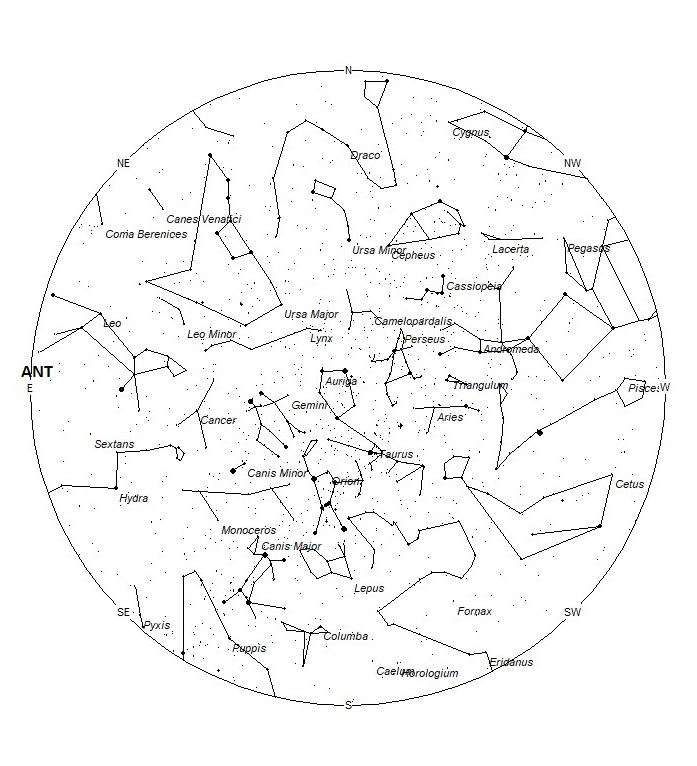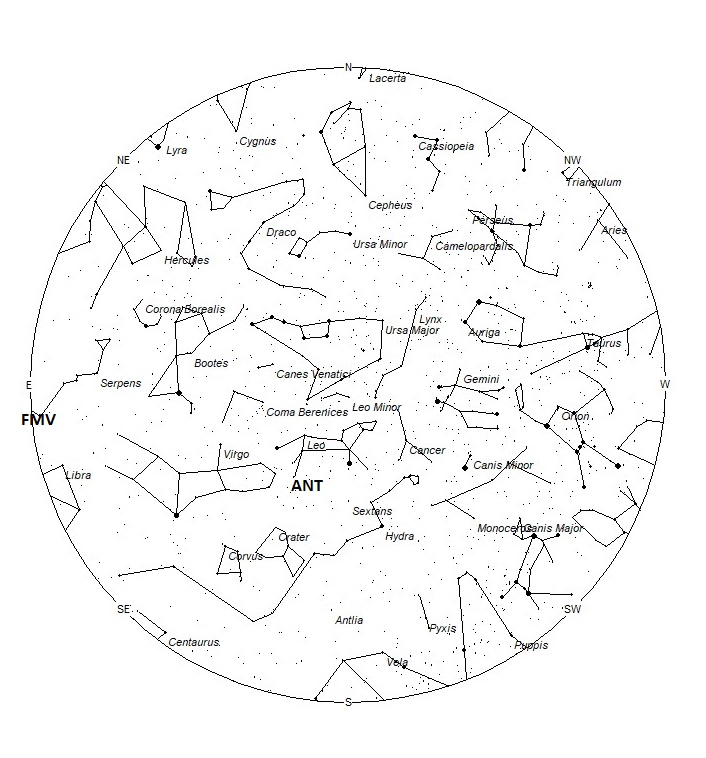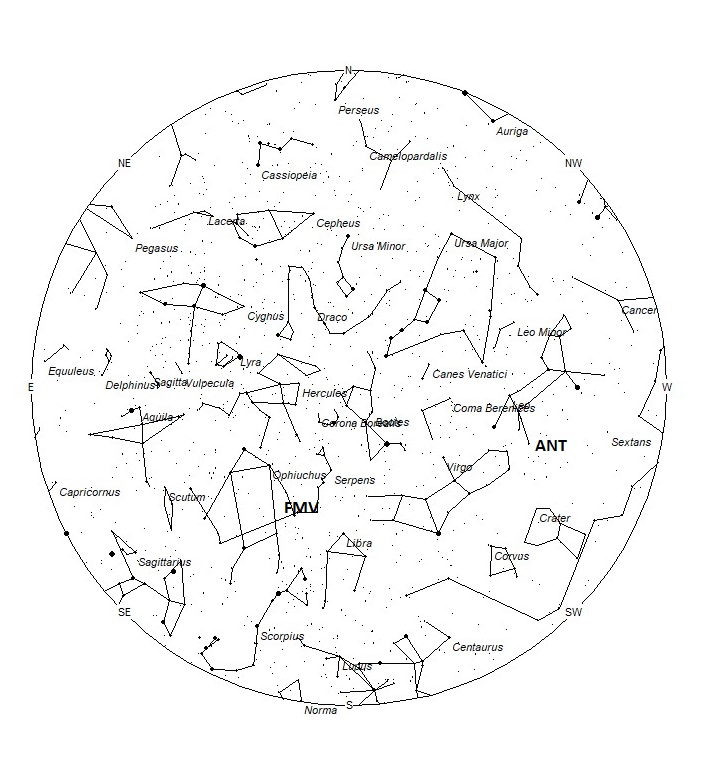
During this period the moon reaches its new phase on Sunday February 23rd. At this time the moon will lie near the sun and will be invisible at night. The moon will enter the evening sky later in the week but will not interfere with meteor observing. This is the best time of the month to view meteor activity as the moon will not be a factor at all. The estimated total hourly meteor rates for evening observers this week is near 3 no matter your location. For morning observers the estimated total hourly rates should be near 8 as seen from mid-northern latitudes (45N) and 13 as seen from tropical southern locations (25S). The actual rates will also depend on factors such as personal light and motion perception, local weather conditions, alertness and experience in watching meteor activity. Note that the hourly rates listed below are estimates as viewed from dark sky sites away from urban light sources. Observers viewing from urban areas will see less activity as only the brighter meteors will be visible from such locations.
The radiant (the area of the sky where meteors appear to shoot from) positions and rates listed below are exact for Saturday night/Sunday morning February 22/23. These positions do not change greatly day to day so the listed coordinates may be used during this entire period. Most star atlases (available at science stores and planetariums) will provide maps with grid lines of the celestial coordinates so that you may find out exactly where these positions are located in the sky. A planisphere or computer planetarium program is also useful in showing the sky at any time of night on any date of the year. Activity from each radiant is best seen when it is positioned highest in the sky, either due north or south along the meridian, depending on your latitude. It must be remembered that meteor activity is rarely seen at the radiant position. Rather they shoot outwards from the radiant so it is best to center your field of view so that the radiant lies at the edge and not the center. Viewing there will allow you to easily trace the path of each meteor back to the radiant (if it is a shower member) or in another direction if it is a sporadic. Meteor activity is not seen from radiants that are located below the horizon. The positions below are listed in a west to east manner in order of right ascension (celestial longitude). The positions listed first are located further west therefore are accessible earlier in the night while those listed further down the list rise later in the night.
These sources of meteoric activity are expected to be active this week.
.
The center of the large Anthelion (ANT) radiant is currently located at 11:08 (167) +05. This position lies in southeastern Leo, 2 degrees southwest of the 4th magnitude star known as sigma Leonis. Due to the large size of this radiant, Anthelion activity may also appear from Sextans and western Virgo as well as southeastern Leo. This radiant is best placed near 0200 local standard time (LST), when it lies on the meridian and is located highest in the sky. Rates at this time should be near 2 per hour no matter your location. With an entry velocity of 30 km/sec., the average Anthelion meteor would be of slow velocity.
The February mu Virginids (FMV) were discovered by Damir Šegon and the Croatian Meteor Network team based on studying SonotaCo and CMN observations (SonotaCo 2007-2011, CMN 2007-2010). These meteors are active from February 17 through March 5 with maximum activity occurring on February 26. The current radiant position lies near 16:12 (243) -03, which actually places it in southeastern Serpens Caput, just northwest of the 3rd magnitude star known as Yed Prior (delta Ophiuchi). Rates are expected to be near 1 per hour no matter your location. These meteors are best seen during the last hour prior to dawn when the radiant lies highest above the horizon in a dark sky At 62 km/sec. the February mu Virginids would produce mostly swift meteors.
As seen from the mid-northern hemisphere (45N) one would expect to see approximately 5 sporadic meteors per hour during the last hour before dawn as seen from rural observing sites. Evening rates would be near 2 per hour. As seen from the tropical southern latitudes (25S), morning rates would also be near 10 per hour as seen from rural observing sites and 3 per hour during the evening hours. Locations between these two extremes would see activity between the listed figures.
The list below offers the information from above in tabular form. Rates and positions are exact for Saturday night/Sunday morning except where noted in the shower descriptions.
| SHOWER | DATE OF MAXIMUM ACTIVITY | CELESTIAL POSITION | ENTRY VELOCITY | CULMINATION | HOURLY RATE | CLASS |
| RA (RA in Deg.) DEC | Km/Sec | Local Standard Time | North-South | |||
| Anthelion (ANT) | – | 11:08 (167) +05 | 30 | 01:00 | 2 – 2 | II |
| February mu Virginids (FMV) | Feb 26 | 16:12 (243) -03 | 65 | 07:00 | 1 – 1 | IV |
 American Meteor Society
American Meteor Society



Thank you for your updates. I truly love them. Unfortunately in extreme North west Montana (110 miles from the Canadian border, we endure many nights of cloud coverage.) Non the less, I am constantly going outside to glance at the skies hoping for some clearance to view what is available. Keep up the fantastic work, I do appreciate it!!!
I find it a bit strange that I’ve seen multiple fireballs for the past 4 days in the midwest moving in different directions each time… so tried to find an article on a possible meteor shower that might be happening with no avail… Then this pops up out of nowhere???
I saw what looked to be 2 shooting stars last night (February 22) at around 11pm GMT over North Wales in the UK
I have seen those meteors many times during milliseconds, though not so big and bright, – just wondering how such excellent images can be taken? You need to set up a camera and wait.. wait,. wait… Like fishing but with far less probability to catch anything.
A fabulous service you provide. My. First awareness of such a very informative source. Thank you.
has anyone notices objects are flying in and out of the sky now? Also, did anyone see the stars falling last night into what looked like a stargate in the sky?
I saw a meteor in N. Phoenix this morning, Feb. 26, 2020 at 5:33 am. It was the most exciting thing to witness with the naked eye. Many saw it.
I saw a large meteor this morning in Northern California around 5:20 am..It turned blue and then red as it entered our atmosphere.. breathtaking!!
Saw one tonight February 27th at about 9:40 PM in Palm Beach Florida. Very exciting, quite beautiful.
Raquel. My son and I saw the same one too from Jupiter FL. That was AMAZING!
Tonight at about 11:45p.m in West Haven Utah a friend and I witnessed something on fire in which I thought maybe a drone cought on fire falling from the sky or maybe this was a shooting star. But the thing was so close and pure as day we could see the flames and long tail flares dragging behind it. Its nothing either one of us 36yrs old has ever experienced very breath taking and mind blowing it seemed to be headed towards the grounds at such fast speed we both were lost for words so catching it on camera wasn’t an option for us we where just two very lucky people to be out side at the right time to witness one of nature’s most amazing moments
That was a breath taking way to put it.. That’s for sure…
We’ve seen a very bright fireball over Rijeka, Croatia at about 10:35 am.
I saw a half dozen bright fireballs in the north northeast sky within 30 seconds at about 6:20 a.m. MST despite the city lights and medium cloud cover.
I saw a large meteor shooting across the sky like a fireball near the Big Dipper!
It was a beautiful orange color as it faded when leaving the Big Dipper constellation. This happened at 9:27 P.M February 28, 2020! Something I will keep forever in my head.